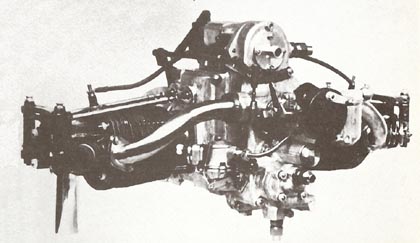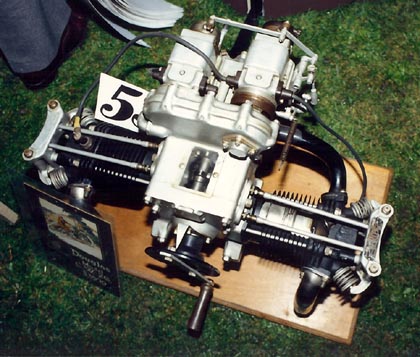Well that is a pretty tall order! Original source information on the Douglas aero engines is pretty scattered. What you see in
The Best Twin is by far the best compilation available on the subject in one spot. Since you have undoubtedly read that, you will know their aeronautical aspirations long proceeded the DT era.
It seems the first factory involvement (verses amateurs converting a second-hand motorcycle engine) centered on the 1923 OHV engine from an S2 model of 733cc (though often classified as a 750.) These were used direct drive and through a chain drive reduction unit bolted to the top of the engine via a very long extended set of crankcase bolts (the S1 and S2 was like the 4hp side-valve in that the crankcase was split horizontally.)
Pictures of the reduction drive:
 Larger view
Larger view Larger view
Larger viewMention is made of a program printed of the 1923 Lympne competition sponsored by the Daily Mail. I have only seen portions of this program, which primarily seem to be little more than just a list of entrants, eleven of the twenty-eight having Douglas engines. I have heard the whole competition was written up in a book
The British Light Aircraft circa 1965, unseen.
Clew then says the next application of a Douglas engine for light aviation was 1932, but this is not quite correct as in the engine prefix appendices of his book there is mention of
GE/1A 4hp. Aero engine (for Royal Aircraft Establishment glider) 1st stamped GE/6 No date, but engine prefix GE/ is assigned to 1923 68x82 engine. This must have been a very early appearance of the OB engine, as the S1/S2 and the RA models had 68mm stroke crankshafts. In any event, I quite by accident ended up with the remains of engine GE/6 with some DT spares, and it is essentially an OB motorcycle engine with aluminized (clad) cylinder barrels and heads. Nothing remains to indicate it was used for aviation.
Publications of the time tend to focus more on the airframes rather than the engine, so anything you cull will be of derivative nature. Publications to look up are
Aeronautical Engineering, Supplement to
The Aeroplane. The September 19, 1923 issue on page 296 has a nice line drawing of Mr. Raynham's Douglas power plant installation.
Then moving on to 1932 we have the well known Sprite, based on the F/G31 motorcycle engine. There seem to have been two versions of these. The first used the cycle barrels. Then a version was made with circular fins on the barrels and horizontal fins on the cylinder heads, better suited to cooling in the aviation application. This latter was 79x82 for 803cc. Both are commonly (miss?) stated as 750cc models, though I wonder if the earlier one was not really a 600cc displacment. I have not seen a publication for the Sprites but I suspect Douglas probably did make a pamphlet. I have also seen a one page of a crudely typewritten data sheet, much like the factory issued for the DT. It references additional sketches for the petrol and oiling systems not seen. They did pass off a Sprite engine as an OW/OW1 engine on the cover of that model's 1934 brochure, the back prop flange is prominently in view, as well as a corner of the AC fuel pump can be seen on the far side! However the crankcase and timing cover joint for the 1934/35 models was completely redesigned from the 1931-33 models, and as shared by the Sprite. The only thing they had in common was the upper end. So to pass it off as an OW/OW1 engine was a bit cheeky.
The F/G31 based Douglas Sprite:
 Larger view
Larger viewThe 79x82mm engine with new cylinders, heads, and timing cover:
 Larger view
Larger viewThese Sprites powered various Planette, Tipsy, Gordon Dove, and B.A.C. Drone designs. It is write-ups on these that are more numerous than information on the engine(s) themselves. Some places to look is a book called
Ultralights (no further information);
Aero and Airways Oct 1935, test report #8,
The B.A.C. Super Drone;
Seventy Hours of Dronish Delight in
Aeroplane Montlhy November 1974; and Vintage Ultralights, B.A.C (Kronfeild) Drone,
Popular Flying Jul-Aug 1983.
Henri Mignet and his Flying Fleas 1990, ISBN i085429-765-0, has some information re- Flea powerplants, Douglas included. It lists a Douglas Sprite of 500cc, 17hp. This is probably meant to be the cycle barrel engine. Then it lists an Aero Engines Sprite, of 803cc displacement, and 25hp. This is the 79x82 engine. There are a number of pictures of Douglas powered Fleas, perhaps the most terrifying using a 4hp side valve engine!
Then then the crankcase was redesigned specifically to suit airframe mounting. The mounting saddles run across the case rather than longitudinal as in the case of the cycles. Also the timing chest was far more elaborate, incorperating dual magneto drive. There is one shown in Clew's book, as well as there being a sectioned engine on display in the Bristol Industrial Museum. The rules requiring dual ignition apparently came out just about this time, catching Douglas by surprise and requiring a redesign. Clew captions this as engine 1800cc, but it shares the same barrels and heads (now with twin spark plugs) as the previous 803cc Sprite. Whether these were intended to also be marketed as the Sprite is unknown. They have been seen with the same brass plate affixed to the rocker perches, but the perches are interchangeable with the smaller engine, so it might be a case of mistaken identity.
The display engine from the Bristol Industrial Museum, at the Bristol Cavalcade 1988:
 Larger view
Larger view Larger view
Larger viewThen there was the
Dryad which was written up and illustrated in
Flight of May 18, 1933. This was stated as a 92x92 engine for a capacity of 1.2 liter. This looks to have been designed from the ground up as an aviation engine, rather than an evolution of a motorcycle engine.
The "Dryad":
 Larger view
Larger viewIt never seems to have gone into production. It had a shaft driven novel cam in head design, almost but not quite OHC, subject of a British Patent 405304, applied Sep. 16, 1932, and accepted Feb 8, 1934. The illustration accompanying the patent shows a conceptual single cylinder test engine.
-Doug
[odd formating characters removed. -Doug 19sep07]